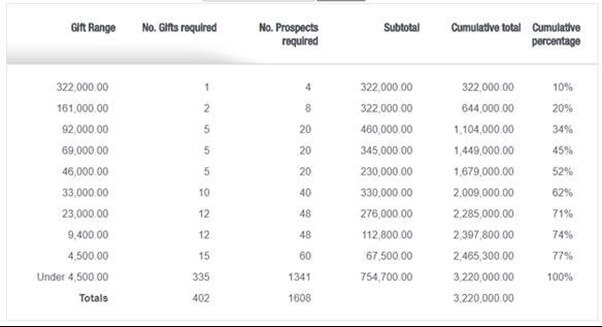If you’re about to launch a major capital campaign, it’s crucial that you have the right data and tracking tools in place to ensure you’re headed towards success. For most organizations, the Giving Pyramid is essential to kick-off and continually monitor your capital campaign. But what is it, and what is the best way to create it? Here are some tips to get your started…
The Giving Pyramid—an Essential Part of Any Capital Campaign

The Giving Pyramid
What is it?
The Giving Pyramid shows whom you should be asking for money, and at what level. It allows you to identify your giving ranges and how many people will need to give within each range for your campaign to reach its goal. It also allows you to track success compared to goal as the campaign unfolds.
Why should fundraisers use it?
As you’re launching into your feasibility studies and campaign planning, you’ll need to figure out which donors to approach and for how much. You want to make sure that your asks are within the correct range for each individual—you don’t want anyone to feel uncomfortable when you ask for far too much, and you certainly don’t want to get less than a donor’s capacity to give.
The Giving Pyramid allows you to determine your asks based on data and without throwing darts on the board. The result is more appropriate asks which will lead to more successful campaign.
How do you create it?
Based on data from past campaigns, you can use a scatter plot to get a quick visual of each individual’s potential giving level. This scatter plot will allow you to identify giving ranges and assign each person to a range. The total number of gifts should add up to your goal. You can then create a pyramid as a visualization of your prospect giving levels, and use it to track progress toward goal.
What are some easy systems to help you do that? Well, according to many articles out there, a Giving Pyramid can be created using a calculator such as found at Blackbaud. But does it really add up?
Here is a Giving Pyramid from Blackbaud’s Calculator for a real-life fundraising effort receiving 3.22 million dollars:

Now let’s use JCA Answer’s comparative of Actual to Calculator visualization to compare this pyramid to what really occurred during this campaign:
Answers comparative of Actual to Calculator:

You can see that the outcome of the campaign was far different from what the calculator predicted. If the organization had used the pyramid from Blackbaud’s calculator, the staff may have been frustrated by not meeting their goals.
Thus, our recommendation is to use JCA Answers to create detailed pyramids. Let’s look at this example of how Answers makes it easy to create accurate pyramids.
Some background: The organization has identified any gift as “Major Giving” if it is above $1,000. It has also identified “Mid-Range Giving”—those above $100, which may take separate forms of appeals. And “Popular Giving” is defined as anything under $100.
Using JCA Answers, we analyzed the range values and grouped them by highlighting noticeable groupings in the scatter chart combined with testing out how pyramid-like the results are in the actual Ranges in the Bar charts. We opted for five buckets per pyramid for a total of 15 ranges.


To check on accuracy, you can apply these ranges to past campaigns. In the chart below, we’ve applied to ranges to campaigns from 1993 and 2003. You can see that the general proportions of the pyramids are staying consistent with the model, with slight variation in the number of gifts (which seem to be increasing).
1993
2003

Of course, in Answers, you can further enhance these dashboards by identifying additional characteristics such as Constituent Attributes and Constituent Code. You can even drill down into dashboards to find details such as constituent contact lists.
We hope these tips are helpful as you create your Giving Pyramid and launch your campaign! For more information about how JCA Answers can guide you toward a successful capital campaign, contact us.
Looking for more nonprofit data insights? Download the Fundraiser’s Guide to Data Analysis.

